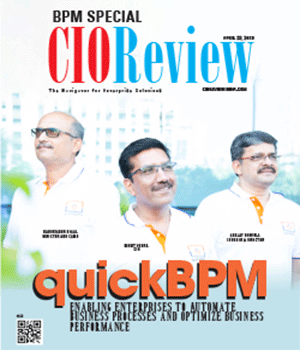
How BPM Helps Accelerate Operational And Business Agility?
Siva Subrahmanyam Chavali, Architect, Digital Integration, Kellton Tech | Friday, 26 April 2019, 07:29 IST
 Siva Subrahmanyam Chavali is an enthusiast and practitioner of Digital Business platform drivers such as API Management, Internet of Things (IoT), MicroServices, DevOps - Continuous Delivery, Cloud, and Hybrid Integration platforms. He is currently working as an Architect with Kellton Tech and has over a decade of experience in building IT integration solutions using Software AG, MuleSoft, and Oracle products. Siva’s areas of focus include evaluation of Enterprise Integration Software such as ESB, MFT, API Management platforms, Continuous Delivery software, and IoT platforms.
Siva Subrahmanyam Chavali is an enthusiast and practitioner of Digital Business platform drivers such as API Management, Internet of Things (IoT), MicroServices, DevOps - Continuous Delivery, Cloud, and Hybrid Integration platforms. He is currently working as an Architect with Kellton Tech and has over a decade of experience in building IT integration solutions using Software AG, MuleSoft, and Oracle products. Siva’s areas of focus include evaluation of Enterprise Integration Software such as ESB, MFT, API Management platforms, Continuous Delivery software, and IoT platforms.
Since the last couple of years, global enterprises have been particularly emphatic about the importance of digital transformation. The hyper - excitement has pervaded the entire IT leadership, from innovative leaders, like Google and Facebook to traditional organizations, where IT is just a nominal helper, taking cognizance of the snow balling digital evolution.
While the disciplines of Customer Experience and Digital Transformation have already been laser targeted for acquiring new-age digital capabilities, Business Process Management (BPM) is the new change-maker on the block.
But, what exactly BPM is and why it is important?
So, BPM is:
• A Core Catalyst that drives agility, efficiency, and scalability across an enterprise’s functional landscape.
• A Strategic Practice that facilitates continual process-oriented enhancements, which are both core and administrative in nature, and boosts growth bottom lines.
• A Methodical Discipline that reforms latent, siloed processes into flexible, well-connected services, which cumulatively improve business performance, enhance customer experience, and deliver transformative value.
The Enterprise BPM landscape, so to speak, is a true reflection of how the companies’ processes are organized and reflects the ease of doing business for the internal and external customers.
"There is no denying that BPM is indispensable for any enterprise looking to achieve operational agility and leave its fingerprints over the evolving digital canvass"
The Importance of BPM in Digital Transformation
Of late, Digital Transformation is the only crowning achievement global enterprises are interested in. Companies that have embraced it fully by exploring Cloud Strategies, Microservices, IoT, and other digital technologies are stallions in a group of mules. For the rest, the idea of transformation is struggling, and the reason boils down to their obsolete, manual-based, and incompetent business processes, which exist both internally and externally.
While transforming digitally holds true to survive the competition, it’s also crucial to be observant of the factors that might be resulting in delays and inefficiencies, and playing a spoiler to the transition. To remain relevant, it’s important to monitor the relevancy(read maturity)score of your enterprise, and replace everything legacy with innovative solutions. Ignorance here could be a potential hindrance to the enterprise growth with respect to all things technology.
The Three-Pronged Approach to Business Process Management
BPM isn’t merely about the tools. It’s about people and processes as well.
1. Process Definition
The first step to solve a problem is to discover and acknowledge that, there is a problem. Process improvisation is an approach towards identifying the functions where there is no process and discovering the pitfalls in the existing processes.
Take the example of traditional organizations, where processes and compliances take precedence over innovation. For them, there is always ‘business as usual,’ which never paves way for anything ‘cutting-edge.’ As a result, they continue to suffer from operational delays, process inefficiencies, higher costs, and stagnant growth.
These organizations might have maintained compliant workflows and well-defined processes, but in these times when technology is highly efficiency-enhancing, it’s important to revisit, recognize, rewire, and rise at the pace of competitive innovation. It’s important to capture the power of emerging technologies and unlock growth advantages to their best.
The whole cycle of process improvisation includes Existing Processes Analysis, Identifying Improvement Areas, Redefining, and Remodeling.
2. Process Optimization
Based on metrics, such as business planning, baseline functions, maturity level and ROI, some companies would qualify for improvisation, while some would be deemed fit for optimization.
Note that adapting to the LEAN Methodology and Continuous Improvement is primarily a Process Optimization method, and deals with Waste Minimization. This is a critical approach directed at achieving quantitative and qualitative benefits, which include enabling more flexible, competent work processes, cost efficiency, and greater customer satisfaction.
3. Process Automation
Automation is programming a system to process a task on its own, thereby mobilizing cost and efficiency benefits. It isn’t just a fix to redundant processes and static workflows. It can also streamline the most complex and highly varying workflows by configuring just the right set of business rules.
Process Automation is largely misconstrued as a potential threat to jobs. But, in reality, it’s a fantastic avenue of opportunity to reduce robotic, monotonous, and laborious burden on the workforce, and help them concentrate better on upskilling themselves and focusing on other strategic priorities.
In the current scheme of things, we believe that there aren’t many organizations with a BPM solution. And if they are having it by any chance, their BPM landscape is immature and limited to smart parts of business units, trying to transform.
There is no denying that BPM is indispensable for any enterprise looking to achieve operational agility and leave its fingerprints over the evolving digital canvass. With an access to multiple Business Process Modeling techniques and extensive tool support available in the market, it’s become easier to energize end-to-end business processes and drive revenue with accelerated automation.
So, why waiting over? Take the plunge!
CIO Viewpoint
Enabling An Effective Workforce With The Proper...
By Daniel M. Horton, CIO, Sallyport Global
Three Ways To Build A Gmail Security Conscious...
By Niraj Ranjan Rout, Co-founder & CEO, Hiver
By Sreenivas Pamidimukkala, CIO, International Paper
CXO Insights
Looking towards Operations Management: What...
By Dr. Vandana Sonwaney, Director, SIOM
Strategic Implementation And Control
By SURESH.V. MENON-PRINCIPAL CONSULTANT SIX SIGMA & STRATEGIC MANAGEMENT, ADVISORY (BUSINESS EXCELLENCE)
Grand Strategies Used In Strategic Management









